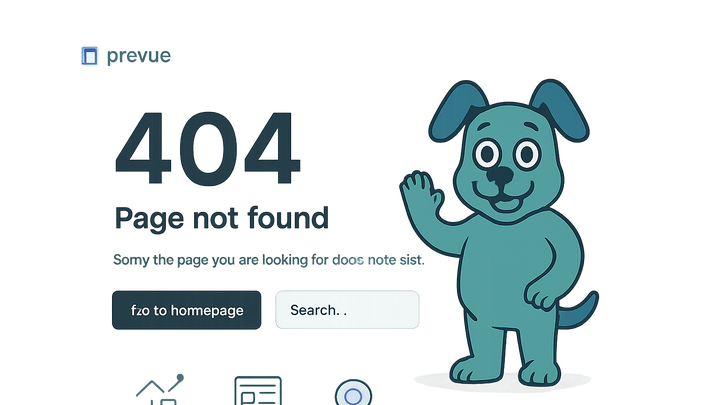Published on 2025-06-29T19:53:42Z
What is a 404 Error Page? Importance for CRO, UX & SEO
A 404 Error Page is a web page displayed when a user attempts to access a URL that no longer
exists or is incorrect. It corresponds to the HTTP status code 404 Not Found. While its
primary function is to inform users that the requested content is unavailable, a well-designed 404 page
can reduce bounce rates, guide visitors back to relevant content, and even drive conversions. From a UX
perspective, clear messaging and intuitive navigation can transform frustration into engagement. SEO-wise,
properly handling and monitoring 404 responses helps maintain crawl efficiency and preserve
link equity. Tools like Prevue.me can audit your 404 pages, offering actionable critiques
for CRO, UX, SEO, and accessibility, turning a potential dead end into a marketing opportunity.
404 error page
A 404 error page signals missing content and, when optimized, can enhance UX, SEO, and conversion rates.
Why 404 Error Pages Matter
Understanding the impact of 404 pages on user satisfaction, search rankings, and conversion opportunities is crucial for any site owner or marketer.
-
User experience impact
A poorly handled 404 can frustrate visitors and increase bounce rates, while a helpful page can guide users back into your site flow.
- Clear messaging:
Use simple, jargon-free language to explain the error and suggest next steps.
- Brand consistency:
Maintain your site’s visual style and tone to reinforce trust, even on error pages.
- Helpful navigation:
Include links to the homepage, popular content, and a search bar to keep visitors engaged.
- Clear messaging:
-
Seo implications
Search engines interpret 404 responses in crawling and indexation, affecting your site’s overall performance.
- Crawl budget efficiency:
Too many broken links waste crawler resources; regularly audit and fix 404s to optimize indexing.
- Link equity preservation:
Implement 301 redirects for high-value removed pages to transfer SEO value to relevant alternatives.
- Crawl budget efficiency:
-
Conversion opportunities
A thoughtfully crafted 404 page can become a conversion touchpoint instead of a dead end.
- Custom calls to action:
Add CTAs like newsletter sign-ups, trial offers, or contact forms to re-engage visitors.
- Embedded search widgets:
Allow users to search site content directly from the 404 page to help them find what they need.
- Custom calls to action:
Technical Considerations
Proper server configuration and monitoring ensure your 404 pages are delivered correctly and tracked effectively.
-
Correct http status code
Ensure the server returns a true 404 status rather than a generic success response.
- Use 404 vs 410 appropriately:
Reserve 404 for temporarily missing content and 410 for permanently removed pages to signal crawlers.
- Avoid soft 404s:
Don’t return a 200 OK status with an error message; this confuses search engines and users alike.
- Use 404 vs 410 appropriately:
-
Managing redirects
Decide when to serve a 404 versus redirecting users to relevant content.
- Implement 301 redirects:
Use permanent redirects for outdated URLs that have suitable replacements.
- Fallback redirect strategies:
Employ wildcard rules or plugins to handle large volumes of broken links efficiently.
- Implement 301 redirects:
-
Monitoring and analytics
Track 404 occurrences to uncover broken links and user pain points.
- Google analytics setup:
Configure custom reports or events to log 404 hits and identify high-traffic missing pages.
- Prevue.me diagnostic reports:
Leverage prevue.me to receive UX, accessibility, SEO, and CRO critiques on your 404 pages.
- Google analytics setup:
Optimizing Your 404 Page Experience
Apply design best practices and continuous testing to turn your 404 pages into user-friendly waypoints.
-
Design and branding
Ensure visual appeal and accessibility while reinforcing brand identity.
- Mobile responsiveness:
Verify that the 404 page renders correctly across all devices and screen sizes.
- Accessible contrast and typography:
Choose colors and fonts that meet WCAG standards for readability.
- Mobile responsiveness:
-
Content and messaging
Craft copy that is empathetic and actionable, guiding users back to your site’s content.
- Friendly and clear tone:
Write empathetic messages that acknowledge the error and suggest helpful steps.
- Links to popular resources:
Offer quick access to top posts, product pages, or support documentation.
- Friendly and clear tone:
-
Testing and iteration
Use data-driven methods to refine your 404 page and boost engagement.
- A/b testing ctas:
Experiment with different calls to action to see which drives the best click-through rates.
- Performance monitoring:
Track metrics like bounce rate, time on page, and conversion events to measure effectiveness.
- A/b testing ctas:
